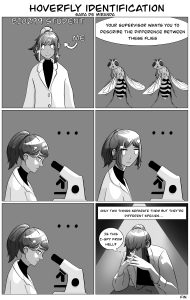As many others interested in pollinators, my field of interest used to be mostly focused on bees, bumblebees and, to a much lesser degree, wasps. When I was assigned the task of investigating the diversity, abundance and phenology of hoverflies in Hardanger, I must admit my slight skepsis as to how interesting a family of flies could be. Hindsight is 20/20 they say, and true to the idiom, I was sorely mistaken in assuming that hoverflies weren´t interesting insects. Who would have thought that I´d be writing this blog (one year after I became hooked on bees) writing about my newly awakened passion for hoverflies.
Hoverflies (Syrphidae) are a family of flies of the Diptera order. Diptera have been shown to be the second most important pollinating insect order we have, only surpassed by the Hymenoptera order, of which include social -and solitary bees and bumblebees. As pollination services are essential for the functionality of ecosystems, the conservation of pollinating species should be of equal importance. Hoverflies are probably most commonly known for their mimicry of wasps and bees, but did you know that they are actually very characteristic for their mimicry on the entire Hymenoptera order? They are a very diverse family of insects, with over 350 species being able to be found in Norway alone!
The task that was assigned to me was to identify hoverflies caught in pan traps and vane traps in connection to the APPLECore project in the spring of 2022. Identifying hoverflies, however, was in no way as simple as I initially thought. I can with all honesty say that I never anticipated the amount of nitpicking, hemming and hawing and second guessing that would go into the identifying these insects, and that properly identifying them would amount to over half of the time spent in this subject. I genuinely never thought I´d miss identifying solitary bees, but here I was, violently missing the relative simplicity of identifying bees and bumblebees.
Especially in the start stages of lab work, I felt extremely out of my depth. However, the most important thing to do when you feel out of your depth is to learn how to swim. Practically, this meant putting in long hours in the lab, reading up on literature and double, triple and even quadruple checking most of the insects that were identified. This meant using multiple sources of identification material, including three separate books for hoverfly identification along with a newly published brochure about hoverflies. Needless to say, this semester has been a steep learning curve and has without a doubt awakened a passion for the subject within me.
To round this off, I can without a doubt recommend this subject to anyone who is looking to become genuinely passionate about a niche field within biology. This subject might be extremely time consuming, and lends for no cut corners, but it allows for students to properly explore what it´s like to be a part of a bigger scientific project, and also to explore subjects that interest them. The day the subject BIO299 is no longer offered at the University of Bergen will be a sad day indeed.
To illustrate a bit what it was like to work in the lab during this semester, I´ve produced a short comic strip for your leisure and I hope it brings a smile to your face, the way hoverflies now bring smile to mine.



